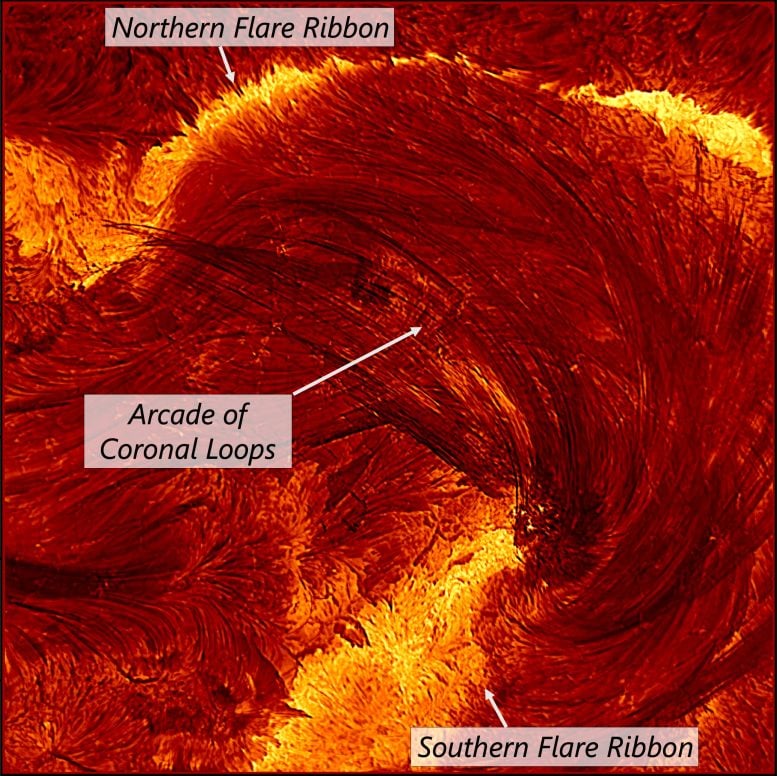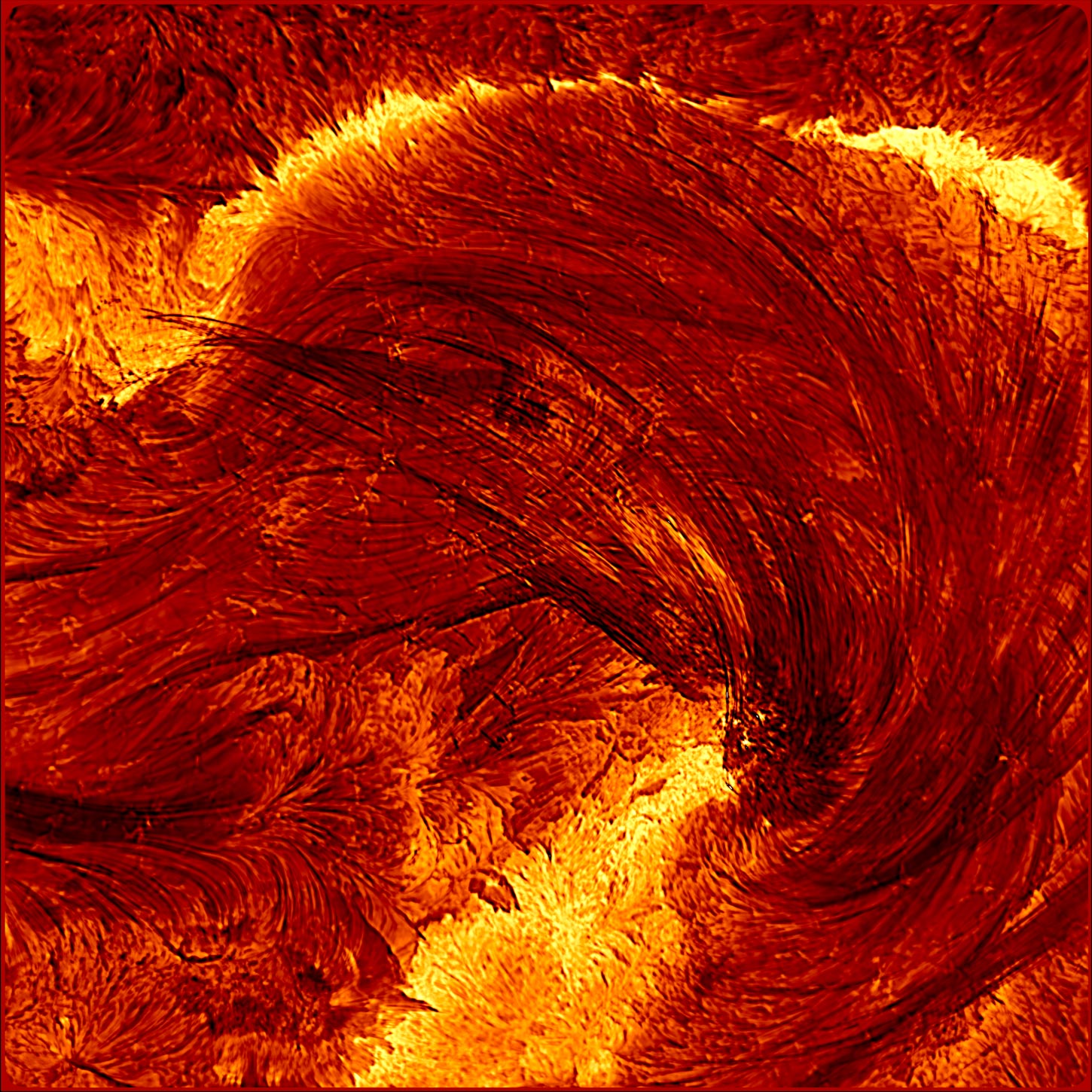Astronomers using the Inouye Solar Telescope have captured the sharpest solar flare images ever taken, revealing delicate, threadlike plasma loops as narrow as 21 kilometers.
These ultra-fine structures, caught during an explosive X-class flare, provide the clearest evidence yet of the Sun’s hidden architecture and may represent the fundamental building blocks of flare activity.
Record-Breaking Solar Flare Imaging
The most detailed images ever taken of a solar flare at the H-alpha wavelength (656.28 nm) are giving scientists a new look at the Sun’s magnetic structures and may improve our ability to predict space weather. Using the U.S. National Science Foundation (NSF) Daniel K. Inouye Solar Telescope, operated by the NSF’s National Solar Observatory (NSO), researchers recorded remarkably fine strands of dark coronal loops during the fading stage of an X1.3-class flare on August 8, 2024, at 20:12 UT. These loops measured an average width of 48.2 km, with some appearing as slim as 21 km. They are the narrowest coronal loops ever seen, representing a major advance in pinpointing the fundamental scale of these features and expanding the boundaries of solar flare modeling.
Coronal loops are glowing arcs of plasma shaped by the Sun’s magnetic field lines. They often appear before solar flares, which occur when certain magnetic field lines twist and break, releasing bursts of energy. These eruptions drive solar storms that can disrupt Earth’s satellites, power grids, and communication systems. By observing at the H-alpha wavelength (656.28 nm), the Inouye telescope can highlight specific features of the Sun that remain invisible in other kinds of observations.
A high-cadence, high-resolution movie of the flare, captured by the Inouye Solar Telescope, has been sped up 100 times. Both bright ribbons and dark overlying coronal loops are visible. The image is about 4 Earth diameters on each side. Credit: NSF/NSO/AURA
First X-Class Flare Observed by Inouye
“This is the first time the Inouye Solar Telescope has ever observed an X-class flare,”explains Cole Tamburri, the study’s lead author. Tamburri is supported by the Inouye Solar Telescope Ambassador Program while pursuing his Ph.D. at the University of Colorado Boulder (CU). Funded by the NSF, the program is designed to train Ph.D. students as part of a connected network of early-career scientists at U.S. universities who will share expertise in Inouye data analysis across the solar research community. “These flares are among the most energetic events our star produces, and we were fortunate to catch this one under perfect observing conditions.”
The research team, which included scientists from the NSO, the Laboratory for Atmospheric and Space Physics (LASP), the Cooperative Institute for Research in Environmental Sciences (CIRES), and CU, concentrated on the delicate magnetic loops spread above the flare’s bright ribbons. In total, hundreds of these features were visible, averaging around 48 km in width, with some loops right at the telescope’s resolution limit. “Before Inouye, we could only imagine what this scale looked like,” Tamburri explains. “Now we can see it directly. These are the smallest coronal loops ever imaged on the Sun.”

Pushing Resolution Limits in Solar Science
The Inouye’s Visible Broadband Imager (VBI) instrument, tuned to the H-alpha filter, can resolve features down to ~24 km. That is over two and a half times sharper than the next-best solar telescope, and it is that leap in resolution that made this discovery possible. “Knowing a telescope can theoretically do something is one thing,” Maria Kazachenko, a co-author in the study and NSO scientist, notes. “Actually watching it perform at that limit is exhilarating.”
While the original research plan involved studying chromospheric spectral line dynamics with the Inouye’s Visible Spectropolarimeter (ViSP) instrument, the VBI data revealed something unexpected treasures—ultra-fine coronal structures that can directly inform flare models built with complex radiative-hydrodynamic codes. “We went in looking for one thing and stumbled across something even more intriguing,” Kazachenko admits.
Confirming Theories on Coronal Loop Scales
Theories have long suggested coronal loops could be anywhere from 10 to 100 km in width, but confirming this range observationally has been impossible—until now. “We’re finally peering into the spatial scales we’ve been speculating about for years,” says Tamburri. “This opens the door to studying not just their size, but their shapes, their evolution, and even the scales where magnetic reconnection—the engine behind flares—occurs.”
Perhaps most tantalizing is the idea that these loops might be elementary structures—the fundamental building blocks of flare architecture. “If that’s the case, we’re not just resolving bundles of loops; we’re resolving individual loops for the first time,” Tamburri adds. “It’s like going from seeing a forest to suddenly seeing every single tree.”
Breathtaking Imagery and Landmark Moment
The imagery itself is breathtaking: dark, threadlike loops arching in a glowing arcade, bright flare ribbons etched in almost impossibly sharp relief—a compact triangular one near the center, and a sweeping arc-shaped one across the top. Even a casual viewer, Tamburri suggests, would immediately recognize the complexity. “It’s a landmark moment in solar science,” he concludes. “We’re finally seeing the Sun at the scales it works on.” Something made only possible by the NSF Daniel K. Inouye Solar Telescope’s unprecedented capabilities.
Reference: “Unveiling Unprecedented Fine Structure in Coronal Flare Loops with the DKIST” by Cole A. Tamburri, Maria D. Kazachenko, Gianna Cauzzi, Adam F. Kowalski, Ryan French, Rahul Yadav, Caroline L. Evans, Yuta Notsu, Marcel F. Corchado-Albelo, Kevin P. Reardon and Alexandra Tritschler, 25 August 2025, The Astrophysical Journal Letters.
DOI: 10.3847/2041-8213/adf95e
Never miss a breakthrough: Join the SciTechDaily newsletter.
